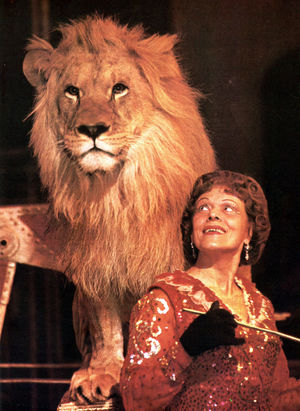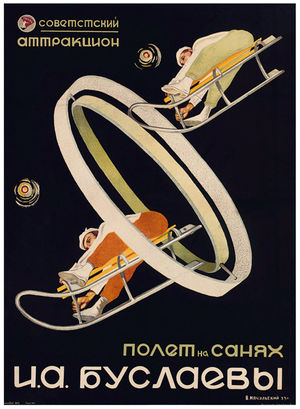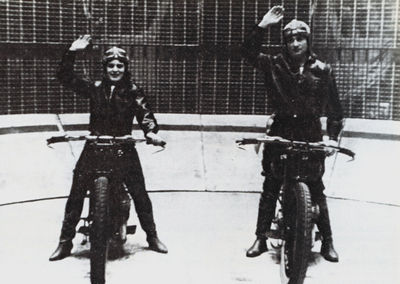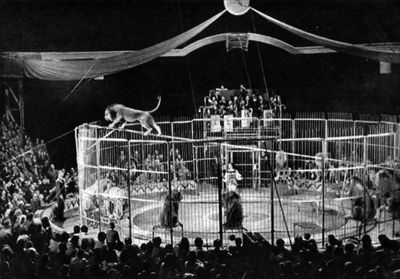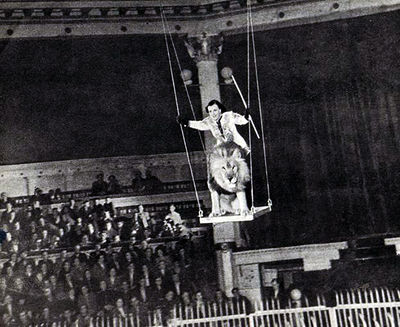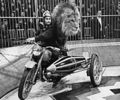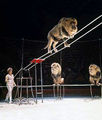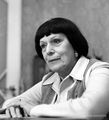Difference between revisions of "Irina Bugrimova"
From Circopedia
(→From Competitive Sports to The Circus) |
(→Image Gallery) |
||
| Line 73: | Line 73: | ||
<Gallery> | <Gallery> | ||
| + | File:Bugrimova_and_Bear.png|Irina Bygrimova and her Bear (1912) | ||
File:Young_Bugrimova.jpg|Irina Bugrimova (c.1930) | File:Young_Bugrimova.jpg|Irina Bugrimova (c.1930) | ||
File:Buslaevi_Poster.jpg|Poster for the Buslaevs' sled attraction (c.1935) | File:Buslaevi_Poster.jpg|Poster for the Buslaevs' sled attraction (c.1935) | ||
Revision as of 01:44, 12 May 2022
Daredevil, Equestrienne, Animal Trainer
By Dominique Jando
A former competitive track and field champion with a taste for dangerous stunts, Irina Bugrimova (1910-2001) was a true legend of the Soviet circus. She had performed as a circus daredevil and a high-schoolA display of equestrian dressage by a rider mounting a horse and leading it into classic moves and steps. (From the French: Haute école) rider before finding her true calling as a very successful lion trainer. She became a major star of the Soviet circus in an era where female cat trainers were unheard of in the USSR: For a time, Bugrimova's only competition in that domain was Margarita Nazarova (1926-2005), another Soviet circus legend, who began performing in the cage fourteen years after her!
From Competitive Sports to The Circus
Irina Nikolaevna Bugrimova (Ирина Николаевна Бугримова) was born March 13, 1910, in Kharkov in Ukraine, which was then part of the Russian Empire. Her father, Nikolai Bugrimov, was a professor of veterinary medicine. Her mother, Aleksandra, came from an aristocratic family: Her father, Iosif Iosifovich Fedorovich, had been Admiral of the Russian Fleet. Alksandra had a strong artistic bent; she was an accomplished pianist, an artist, and showed a great interest in the art of photography. Irina was the fourth child of Nikolai and Aleksandra Bugrimovi, who, coincidentally, bore the first names of the Russian ill-fated Tsar and Tsarina; it is just as the Bolshevik revolution started that Irina, who was seven years old, began studying music and ballet at the Kharkov Opera studio.
A restive child, Irina became interested in competitive sports; she played hockey, did speed skating, and competed in track and field, from long and high jumps to discus, spear, and weight throwing. She won many competitions and, in 1927, became the weight throw Ukrainian champion, and in 1928, she won the same title for discus. Meanwhile, as a teenager, young Irina often helped her father when he treated horses and wild animals at the state circus of Kharkov, and she thus became familiar with animals of all sorts—as well as with the circus world, for which she developed a keen interest.
Her academic education continued during all that time and, from 1926 to 1928, Irina went to study at Kharkov's Commercial and Industrial School. She was eighteen when she graduated; it is also at that time that she became interested in yet another sport, motorcycle racing, which led her in 1930 to meet the champion racer Aleksandr Nikolaevich Butenko. Butenko, who will later be known by his stage name, Aleksandr Buslaev (1894-1976), was sixteen years Irina's senior but she nonetheless fell in love, and they got married.
Under the stage name of Buslaevi (The Buslaevs in Russian spelling), Alksandr and Irina presented their attraction(Russian) A circus act that can occupy up to the entire second half of a circus performance. for the first time in 1930 at the State Circus of Kharkov. It was not a small affair: In a mountain setting, a ramp came from the top of the house (above the orchestra, which traditionally, in Russian circus buildings, faces the ring entrance) down to the ring, above which it curved up at the end; the sleds went down the ramp, were propelled up in a somersault through a revolving hoop, and landed onto another ramp, where they concluded their course in a safety net. Later, the hoop was replaced by two hoops on the same axis revolving in opposite directions!
Aleksandr and Irina entered the ring in white skiers' outfits, performed a few dance steps, and proceeded to climb up to the top of the ramp where the sleds waited. Aleksandr was the first to go and Irina followed him. It was a remarkable thrill actA spectacular act that focuses on the display of danger, whether real or staged., totally original and quite dangerous, which immediately obtained a considerable success. Two years after their debut, they were featured in the Soviet Union's premier circuses, the old Circus Ciniselli in Leningrad (today's St. Petersburg) and Moscow's Circus on Tvetsnoy Boulevard: They had reached star status. Meanwhile, Irina had put together a high-schoolA display of equestrian dressage by a rider mounting a horse and leading it into classic moves and steps. (From the French: Haute école) act that she presented as Irina Buslaeva in the same shows and became her second act—which she kept for most of her career.
Send In the Lions
By 1939, Aleksandr and Irina had performed their attraction(Russian) A circus act that can occupy up to the entire second half of a circus performance. several times in each circus of the Soviet Union; its novelty was on the wane, and they decided to create a new act. Since the time of her visits to the circus with her veterinarian father, Irina had always dreamed of training big cats. She gave it a first try in 1937 when the central State Circus organization, which wanted to have a female cat trainer(English/American) An trainer or presenter of wild cats such as tigers, lions, leopards, etc., acquired a group of leopards and offered up their presentation to Irina. She gave it a try but was not satisfied; she had her views on larger and more spectacular felines—and on lions in particular.So, the Buslaevs acquired three young lions (named Kaï, Julius, and Caesar) and Irina began to train them. During rehearsals, she received some assistance from the legendary cat trainer(English/American) An trainer or presenter of wild cats such as tigers, lions, leopards, etc. Boris Eder (1894-1970), whose many pupils have included such outstanding trainers as Margarita Nazarova and Walter Zapashny. During that time, the Buslaevs performed another thrill actA spectacular act that focuses on the display of danger, whether real or staged. at Moscow's popular Culture and Leisure Park (Gorky Park), a "wall of death," in which they raced at full speed on their motorcycles on a circular wall made of sturdy cage panels. The attraction(Russian) A circus act that can occupy up to the entire second half of a circus performance., which met with great success, was known as The Barrel.
They finally presented their lion act in 1940. Like their previous creations, it was utterly original. It began with Irina having classic figures performed by her three lions; then she brought her motorbike in the cage, and circled it on a peripheral inclined floor, with the lions resting in the center. Aleksandr followed her on another bike with a sidecar (in the shape of a rocket, it was there to ensure the stability of the bike) and started a chase with one of the lions; the latter eventually jumped and sat on a small platform on the backseat behind Aleksandr and circled the ring with him.
Presented as an "attraction(Russian) A circus act that can occupy up to the entire second half of a circus performance."—in Russia, an extended act that occupies a large part, if not all, of the second act of a show—the act was titled Circle of Courage. It was truly novel, and spectacular enough, and it obtained immediately a great success. Then, in June 1941, the Soviet Union declared war to Germany; luckily, Aleksandr Buslaev, who was forty-seven, was too old to be drafted, and he and Irina were able to continue working with their lions through the troubled times of what the Russians call "The Great Patriotic War."Yet, despite their artistic success, their marriage was on the rocks. In 1945, Irina was thirty-five, sixteen years younger than Aleksandr (who was fifty-one then), and in the prime of life. Furthermore, both had strong personalities, but it was Irina who was the true star of the act; they were increasingly arguing with each other over everything, which also had a bad influence on their work together. Finally, in 1947, the war having come to an end, they decided to divorce and ended their partnership. Irina kept the lions and Buslaev went on to pursue a career of his own.
He seems to have continued as a cat trainer(English/American) An trainer or presenter of wild cats such as tigers, lions, leopards, etc., but if so, his work must have been a little lackluster: Buslaev disappeared from the Russian circus chronicles until 1958, when he reappeared in the spotlight with his new wife, Tamara Nikolaevna Buslaeva, in an attraction(Russian) A circus act that can occupy up to the entire second half of a circus performance. titled The Riding Lions. It consisted of a short high-schoolA display of equestrian dressage by a rider mounting a horse and leading it into classic moves and steps. (From the French: Haute école) display by Aleksandr, followed by the presentation of three adult lions jumping up on trotting horses and riding them. A true sensation, The Riding Lions became a star attraction(Russian) A circus act that can occupy up to the entire second half of a circus performance. of the Soviet circus and toured abroad with various units of the Moscow Circus. Aleksandr Buslaev retired five years later, in 1963, at age sixty-nine.
Enter Irina Bugrimova
A riding lion, however, was not a complete novelty in the Soviet circus: Irina had done it before Aleksandr. Left with her three male lions (Caesar, her favorite, will stay with her for twenty-three years!), she acquired two more, trained them and added them to the group. In 1946, having reverted to her maiden name, Irina Bugrimova debuted a new act, more classic in form, but with the added interest that she was still the only female cat trainer(English/American) An trainer or presenter of wild cats such as tigers, lions, leopards, etc. of the Soviet circus. The group would grow larger (it would eventually peak at eleven lions—and Irina trained a total of about seventy lions and tigrons during her career) and she quickly began to add to her repertoire some tricks that rendered her act quite exceptional.The first was the riding lion. It was not something new in the circus world—the Hagenbecks began training riding lions in 1889—but it was new in Soviet Union (and had not been seen in Imperial Russia). In any event, by international circus standards, it was, and still is, extremely rare! The second was the tightrope-walking lion: A lion who walked up two inclined parallel tightropes over the entire width of the cage, starting from one side, at man's height, and ending at the opposite side, on the very top (and edge!) of the cage. This was a truly extraordinary training feat, since the lion had to do it by himself, without human probing—and then had to climb back down!
The third, which eventually became her signature production and which she originated in the mid-1950s was her finale, in which a lion joined her on a giant swing that was hauled up in the air, swaying high above the cage, under the circus's cupola. The faithful Caesar was the first to perform the stunt. It was indeed unique and extremely spectacular, and Irina kept presenting the trickAny specific exercise in a circus act. until the end of her career. Although it has since been copied by a few cat trainers, it has remained extremely rare for obvious reasons.
In the cage, Irina was calm, elegant, and in control; she dispensed with the histrionics that had frequently been displayed by male trainers who, much too often, made themselves the center of attention. In the beginning, she also displayed a young, beautiful figure that contrasted advantageously with the strong appearance of her wild male partners—although since her career as a lion trainer lasted, astonishingly, more than three decades, in her later years, this aspect of her personality had evidently faded away. However, by then, she had become a Soviet circus living legend!She remarried with Konstantin Arkadyevich Parmakyan, a former acrobat and aerialistAny acrobat working above the ring on an aerial equipment such as trapeze, Roman Rings, Spanish web, etc.. From 1946 to 1950, he had partnered with Elena Avanesova in an aerial duet, but, more perhaps to Irina's taste, he had been, like Avanesova, part of the troupe of Piotr Mayatskiy (1905-1968), who had presented a motorcycle thrill actA spectacular act that focuses on the display of danger, whether real or staged. on an inclined track around the ring in the late 1930s and early 1940s. After marrying Irina, Parmakyan became one of her assistants and appeared with her in a double high-schoolA display of equestrian dressage by a rider mounting a horse and leading it into classic moves and steps. (From the French: Haute école) act.
Like all cat trainers, Irina had her share of incidents with her lions, but in 1976, during a performance in Lviv, in her native Ukraine, she was attacked in the ring by several lions and owed her life to the quick intervention of her assistants. She was sixty-six then, and her reflexes were not as quick as they had been. Thus, she finally decided to call it quits and retired from performing that very same year.
One of her assistants then was Boris Biryukov, a former bear trainer who had joined Irina in 1954, and whom she had taught to work with her lions. Therefore, she passed on the act to Biryukov, who presented it, with many variances, until his retirement from the ring in 1996—when he became Director of the State Circus of Voronezh, in Russia. Biryukov didn't have Irina's showmanship, but nonetheless, he and his lions toured abroad with various units of the Moscow Circus; over the years, Irina had visited Iran, Poland, Czechoslovakia, Bulgaria, East Germany, Mexico and Japan with her act, but, unlike Biryukov, she had never worked in Western Europe.
Epilogue
Irina Bugrimova retired in Moscow, where she remained quite active; she became the chairperson of the Veterans of the Russian State Circus Company, was member of the Presidium of the Central House of Artists (an independent cultural association whose members came from all aspects of the arts, whether plastic arts or performing arts) and of the Society for the Protection of Animals. She also became a familiar figure in the juries of several European circus festivals, notably the Festival Mondial du Cirque de Demain in Paris. She died of a heart attack on February 20, 2001, at the ripe age of ninety-one. She was laid to rest at the Troekurovsky cemetery in Moscow.
In the old Soviet Union, whether in the arts or elsewhere, one had to join the Communist Party to achieve a good social status. Like many of her colleagues, so did Irina, whose achievements were rewarded with such Soviet honors as the Order of the Red Banner of Labor and the Order of the Badge of Honor, and, after her retirement, the medal of Hero of Socialist Labor, the Order of Merit to the Fatherland, and the prestigious Order of Lenin. But, much more significantly, she was made Honored Artist of the RSFSR (Russian Soviet Federative Socialist Republic) in 1942, elevated to the rank of People's Artist of the RSFSR in 1958, and finally made People's Artist of the USSR in 1969—the highest honor for a Soviet artist.In 2000, on the occasion of Irina Bugrimova's ninetieth birthday, her name was added to the Circus Artists' Walk of Fame in the foyer of Moscow's Bolshoi Circus on Vernadsky Avenue. In 2010, to celebrate the 100th anniversary of her birth, the Russian Postal Service issued a stamp to her effigy and, in Kharkov, the square in front of the new State Circus was renamed after her. Finally, in 2019, her portrait figured among the few artists featured on the support image that accompanied the Russian postage stamp celebrating the 100th anniversary of the Russian State Circus.
Suggested Reading
- Irina Bugrimova, На арене и вокруг нее ("In and Around the Ring") (Moscow, Iskusstvo, 1966, re-printed in 1991) — ISBN 5-210-00358-2
- Yuriy Dmitriev, Знаменитости российского цирка ("Celebrities of the Russian circus") (Moscow, Rosspen, 2009) — ISBN 978-5-8243-1163-1
See Also
- Video: Irina Bugrimova, lion act, at the Old Circus in Moscow (1951)
- Video: Irina Bugrimova, lion act (excerpts), in the movie Cirkus v Cirkuse (1975)
